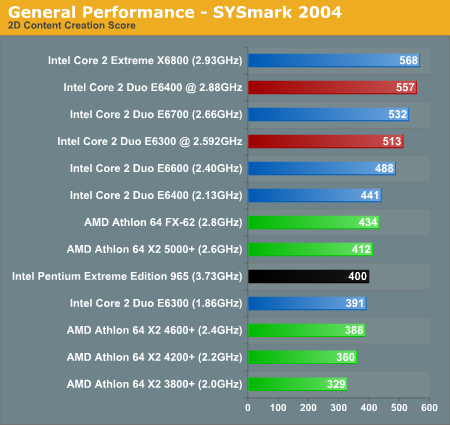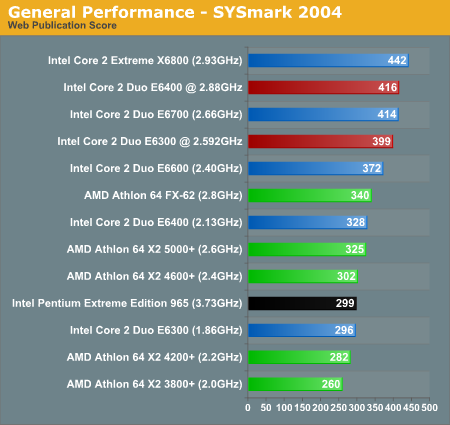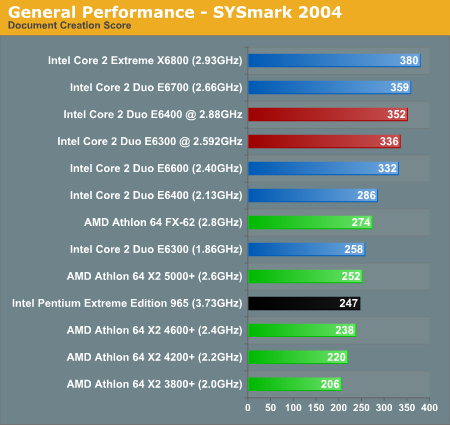Intel Core 2 Duo E6300 & E6400: Tremendous Value Through Overclocking
by Anand Lal Shimpi on July 26, 2006 8:17 AM EST- Posted in
- CPUs
Application Performance using SYSMark 2004 SE
We'll kick off our look at general application performance with SYSMark 2004 SE and as always, we'll look at the overall score as well as the scores in each of the two suites - Internet Content Creation and Office productivity.



The applications tested by SYSmark 2004 cover the vast majority of the modern computing spectrum. Everything from multimedia to office to multitasking performance is included, and while not every application will show a substantial performance increase with a faster processor, the overall performance spread among the tested CPUs is almost 75%. If you routinely do a lot of computationally intensive work on your system (surfing the web and writing email generally don't count), there's no question that you will see a substantial difference between the fastest and slowest systems we're testing.
Our first look at the E6300/E6400 with overclocking generates some interesting results. There has been speculation that one of the reasons Core 2 Duo chips perform so well is that they have so much L2 cache. Dropping from 4 MB to 2 MB of cache does hurt performance a bit, but with a little bit of overclocking both of our budget Core 2 Duo chips perform very well. The net loss appears to be about 200 MHz, so the 2.88 GHz E6400 roughly equals the 2.66 GHz E6700, and the 2.59 GHz E6300 roughly matches the 2.4 GHz E6600. Drilling down into the individual benchmark results for SYSmark 2004, the impact of the reduced cache is more apparent in Office Productivity applications than it is in the Internet Content Creation results, but the 2MB Core 2 chips preform respectably regardless of the application being tested. Perhaps a Core 2 with 1MB or less of L2 wouldn't perform all that well, but since those parts don't exist there's no reason to worry about hypothetical bottlenecks right now.
Switching over to the AMD versus Intel comparisons, the E6300 and E6400 already compete very well, and once we throw in overclocking they are basically out of reach of any of the AM2 processors -- with or without overclocking. In overall score, the overclocked E6300 is almost 20% faster than the FX-62. A 20% overclock of the FX-62 (3.33 GHz) might close the gap, but it would certainly require more than stock air cooling, and it doesn't change the fact that we are able to get extremely good performance out of Intel's $180-$220 parts.
The individual SYSMark 2004 SE scores are graphed below if you're interested; the data is used in calculating the overall scores we've already discussed above:
















137 Comments
View All Comments
Comdrpopnfresh - Wednesday, July 26, 2006 - link
Unfortunately, this article goes on the assumption that the AMD chips are not overclocked. To say that the low-end intel chips offer overclocked performance that the AMD FX-62 cannot reach is absurd. With an unlocked multiplier, the FX can certainly stay above Core2's low end. The same could be said for Lower End X2's.... I'd like to see a review with them overclocked compared to Core2's at stock.... Especially since such CPUs on the 939 socket are mature and heavily supported by outstanding overclocking mobos....OcHungry - Wednesday, July 26, 2006 - link
Just be patient till advertizing budget is dried up.I wish AMD was more co-operative in paid per review market that has plagued "money buys" technology.net.
goinginstyle - Thursday, July 27, 2006 - link
Dear OC-Sharikou,AMD would have that ability if it were not for that $2.5B loan they just signed and obviously keeping your blog up and running. I hope you are banned for these types of false and mis-leading statements. By the way, where are all of these Intel ads you keep harping about?
Anand Lal Shimpi - Wednesday, July 26, 2006 - link
Advertising and Editorial are completely independent and separate at AnandTech, we have a 3rd party ad agency that handles all advertising and sales. The agency is completely independent from AnandTech, Inc.The OP's points were addressed by the poster above; this article was done after response to the last one asked for more information on the E6300 and E6400. The overclockability of 90nm X2 CPUs is fairly well known, and enough reference points exist within this article to compare overclocked X2 performance vs. E6300/E6400 overclocked performance.
Take care,
Anand
bere - Wednesday, August 2, 2006 - link
Actually I think the article is missleading(not on purpose). To compare a 370FSB OC CPU with a 200FSB on DEF is pointless. I would have OC'ed all at least 2 CPU's from both sides to see what's the best buy for an OC'er.Sorry for my poor english.
jjunos - Wednesday, July 26, 2006 - link
This article also assumes you actually read it. From the article:DigitalFreak - Wednesday, July 26, 2006 - link
Again, STFU